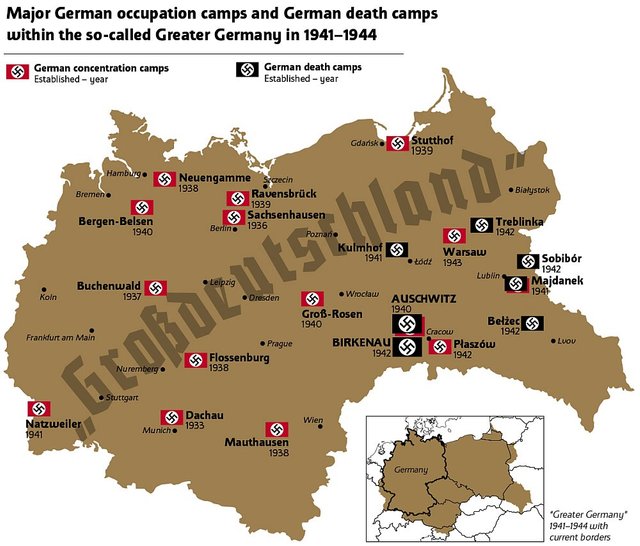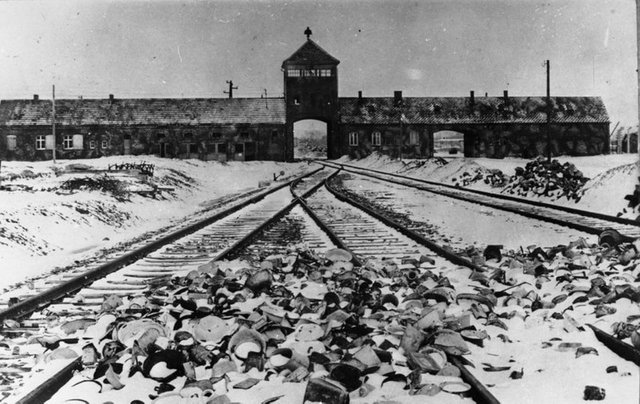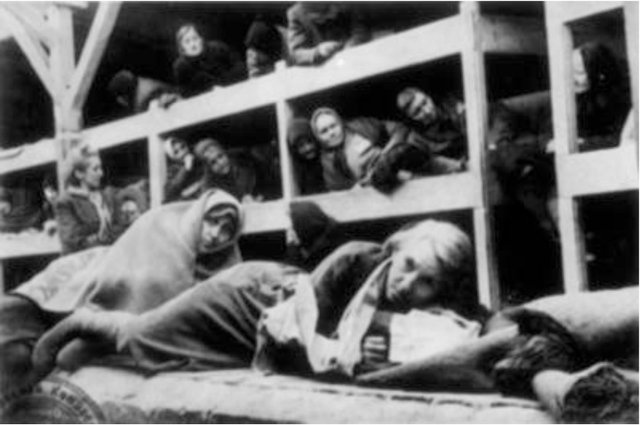Words Matter - German Nazi Camps
Since 2004, Polish diplomacy has been reacting to offensive and false public statements about “Polish concentration camps/Polish death camps” appearing abroad, especially in the media. Each year our Embassy undertakes several dozen interventions requesting that this inaccurate phrase be replaced with the correct terms.
All those interested in this topic should visit the website www.truthaboutcamps.eu where you can find additional information.

German Camps on Occupied Polish Territories during 1939−1945
The First Camps
With its invasion of Poland in September 1939, Nazi Germany planned to destroy not only the Polish state, but also the Polish nation. The Poles who acted for the benefit of Poland were to be murdered while the rest of the nation was to be turned into slaves.
To execute the plan the occupier began to set up camps on Polish territory from the very beginning of the war.
The first ones — the so-called provisional concentration camps — were established as early as October 1939. Arriving in Poland at that time, the German Security Police (Sicherheitsdienst, SD) opened such camps in Poznań (Konzentrationslager Posen — Fort VII) and in Łódź-Radogoszcz (Konzentrationslager Radogosch). The Poles detained there had organized or had been suspected of organizing Polish civilian resistance against the German invader.
Almost simultaneously the German police was setting up camps for the detention of Poles: transit camps for Polish civilian prisoners of war and camps for the interned. Such camps were established for example in Inowrocław (Übergangslager in Hohensalza), Działdowo (Durchgangslager für polnische Zivilgefangene in Soldau), Gdynia (Internierungslager Gotenhafen), Gdańsk (Übergangslager Danzig-Victoria), Sztutowo (Zivilgefangenenlager Stutthof), and Bydgoszcz (Internierungslager Bromberg).
Over 100,000 Poles were detained during the few months of the functioning of the three kinds of camps (provisional concentration camps, camps for Polish civilian POWs, and camps for the interned). The prisoners’ fate was tragic: after cruel interrogations they were shot at 196 mass execution sites, mostly in forests – for example, in the Piaśnik Forest near Wejherowo, in the Szpęgawsk Forest near Starogard Gdański, in the Kaliski Forest near Kartuzy, in the Barbarka Forest near Toruń, in the Dopiewiec Forest near Poznań, the Łagiewniki Forest, and the Lućmierz Forests near Łódź.
Concentration camps
The German invader also establishedconcentration camps on the territories of occupied Poland. The first such concentration camp — KL Auschwitz, with a capacity calculated at 30,000 prisoners — was established in May 1940 in Oświęcim in Silesia (then formally incorporated into the Reich). Its establishment was related to the mass arrests of Poles conducted to prevent further development of the resistance movement, which was spreading far and wide. By the end of 1940 nearly 8,000 Poles suspected of underground membership were detained in the camp. The prisoners of KL Auschwitz’s 40 subcamp did compulsory work for German companies. The nextconcentration camp — KL Lublin, colloquially called Majdanek after the name of the Lublin neighbourhood where it was situated — was established in August 1941. Its capacity was calculated at 25,000−50,000 prisoners. The other two camps which began to operate in 1941 were: the Birkenau concentration camp in Brzezinka (also called Auschwitz II – Birkenau), to which female prisoners were transferred from the male concentration camp of Auschwitz; and KL Gross Rosen in Rogoźnica. In January 1942, in turn, a special Security Police camp in Sztutowo near Gdańsk — Sonderlager Stutthof — was transformed into a concentration camp (KL Stutthof). The first prisoners of the camp were members of the Pomeranian resistance movement. KL Stutthof and KL Gross Rosen had 119 subcamps in occupied Poland and about a dozen subcamps in East Prussia, the Czech Republic, and Germany. The prisoners worked mostly on road construction or in arms factories. The concentration camps’ guards were functionaries of SS units. Camp workshops, storehouses, and offices employed German criminal prisoners transferred from German camps. During the following years of the war and occupation the Third Reich authorities broadened the scope of the duties of the concentration camps established on Polish territories. They became not only places of forced isolation, but also places where the Nazis executed their plan to exterminate the Jews and certain other groups of prisoners. Soviet POWs were the first such group sent to Auschwitz for extermination at the end of 1941: 10,000 of them were starved to death. The Roma (Gypsies) from all over Europe were also brought to Auschwitz for extermination. A part of the camp was assigned to entire Roma families, which were then murdered in the gas chambers. From 1942, when the Germans began to carry out their plan to exterminate the Jews (the so-called final solution to the Jewish question [“Endlösung der Judenfrage”]), Auschwitz started to receive transports of Jews from all over Europe. After arrival they were murdered using cyclone B or exhaust fumes. The Nazis were able to gas and cremate about 9,000 people every 24 hours. Jews from occupied Europe were also sent to and often murdered in KL Lublin, KL Stutthof, and KL Gross-RosenDeath Camps.
Death Camps
The plan to annihilate the Jews of Europe was carried out for the most part in a few death centers located on Polish territory. The first German extermination center started operating on December 8, 1941 in Kulmhof (Chełmno n/Nerem). In 1942, following the infamous Wannsee conference, the occupier established immediate extermination camps in Birkenau, Bełżec, Sobibór, and Treblinka, the three latter camps (and sometimes Majdanek) being called “Operation Reinhardt” camps. The personnel of those camps consisted of members of the SS-Totenkopfverbände and the so-called Trawnikimänner (mostly Ukrainians). The occupier established these immediate extermination camps to annihilate the Jews of Europe. The Roma, Soviet POWs, and Poles who had helped the Jews were also murdered there. The first transports to arrive at the death camp in Chełmno nad Nerem brought Jews from Wartheland. The victims were immediately gassed in trucks (portable gas chambers) with exhaust fumes. The corpses were taken to a nearby forest and burnt on piles of timber. Other victims included the children of Polish families from the Zamość region and Poles from social service institutions in Łódź and Włocławek. The victims of the camp in Chełmno nad Nerem also included Soviet POWs and Jews from Germany, Austria, France, Belgium, and Holland. The German occupier murdered a total of 200,000−300,000 people there. The first transports to arrive at the death camps in Bełżec and Sobibór established in the east of occupied Poland brought Jews from ghettos in the southern and eastern Districts ofThe General Government, that is from the Kraków, Lublin, Radom, and Galicia Districts. The next transports came from the USSR, Austria, Belgium, the Czech Republic, Denmark, Holland, France, Germany, Norway, Romania, and Hungary. Some Poles from the Galicia District, mostly from Lvov, were also brought to the camp in Bełżec, while the camp in Sobibór received transports of Polish children from the Zamość area. The total number of Jewish victims of the camps in Bełżec and Sobibór amounted to approximately 600,000 and 250,000 respectively. The Treblinka death camp> established in northern Mazovia was the site of extermination of Jews deported from the Warsaw ghetto and the ghettos established by the occupier in other town and cities of the Warsaw District. Jews from Germany, Austria, France, Belgium, Yugoslavia, Greece, and the USSR were also sent there. The total number of Jews murdered by the Nazis in this camp amounts to 750,000. The death camp was closed in the autumn of 1943 and at the beginning of 1944. The gas chambers were destroyed, the barracks torn down, and the land where they had been was plowed and grassed over.
The Remaining Categories of Camps
The death camps, concentration camps, and other camps of the Security Police do not exhaust the list of the camps established by the German occupier on Polish territories. Aside from the camps administered by the Security Police, thousands of camps were administered by bodies of the civilian authorities. These included displaced persons’ camps, forced labor camps, and penal camps. The forced labor camps, which exploited the Polish workforce, constituted the largest group. The first ones were established during the winter of 1939 and 1940 as labor camps for Jews. They were gradually closed during 1942−1944 when the Germans were carrying out their plan to exterminate the Jews. In December 1940 the occupier began to organize separateforced labor camps for Poles. The detained worked on road and river embankment construction and performed field, regulatory, soil-improving, and fortification work. The mortality rate in the camps was high due to primitive, non-hygienic living conditions, inadequate food rations, hard work, and terror. The forced labor camps for Poles operated until 1945. The transit DP camps were used during deportations of Poles from the Polish territories designated for complete Germanization. The families detained in the camps were separated. The young and healthy were deported to forced labor in the Reich, while the old, the sick, and children remained in the camps. During the five years of the deportation operations the occupier detained in such camps a total of over 1,200,000 Poles. The penal camps belonged to a different category. They were places where the prisoners not only served their sentences, but also worked.dr Maria Wardzyńska
Rospowszechniajmy gdzie się da. 👍 Netanjachu nie przekonamy, ale wielu ludzi nie ma zielonego pojęcia o sytuacji w Polsce w latach wojny.
@darties: See this post.
Zostawiłem oczywiście upvote'a i resteem (czyli coś w rodzaju udostępnienia). Mam nadzieję, że ten post trafi do szerszego grona odbiorców.
You wrote something in tag #polish. Polish community use this tag for posts with Polish language. We don't want to flag your post but we should do that. This is tag spamming and you won't find many voters here. Please use edit and remove tag #polish or change into something else. OR even better - use our beautiful language!